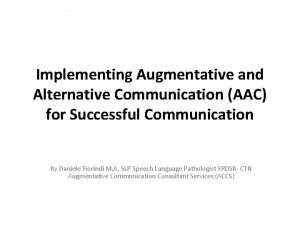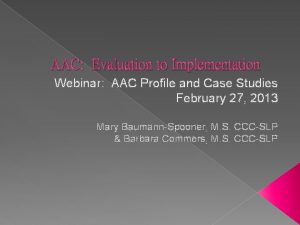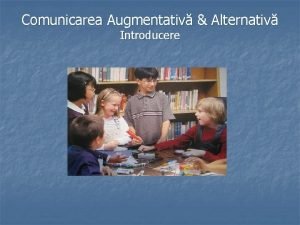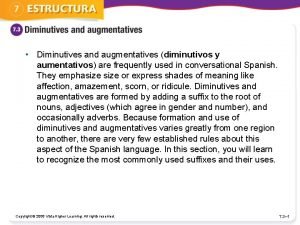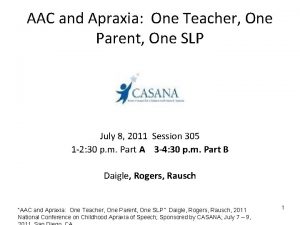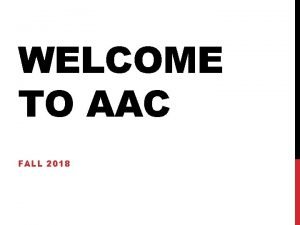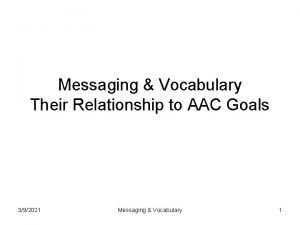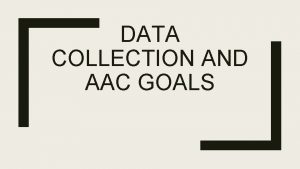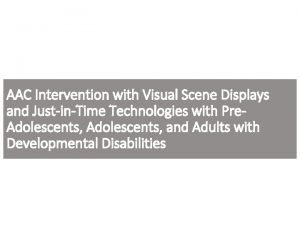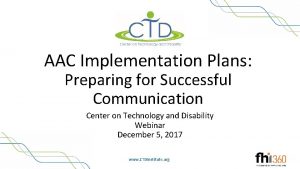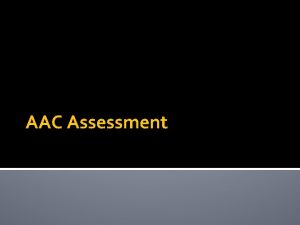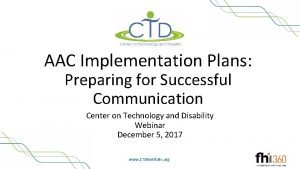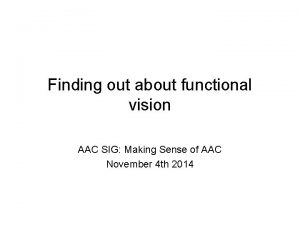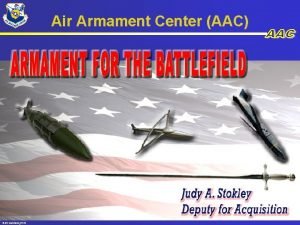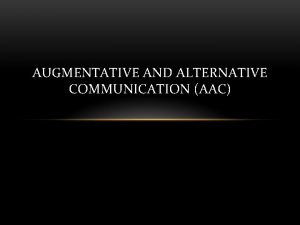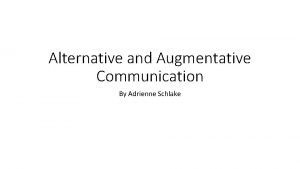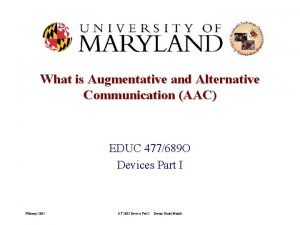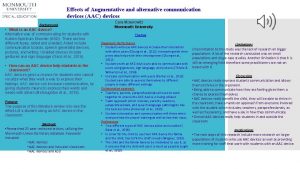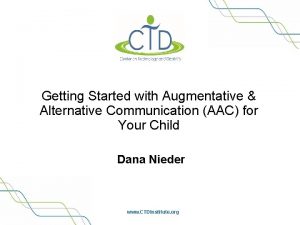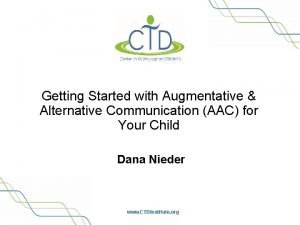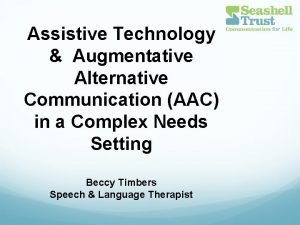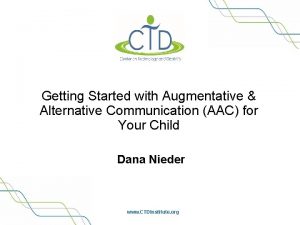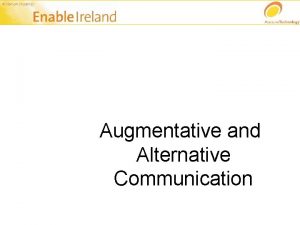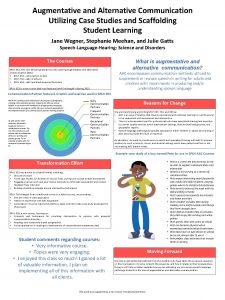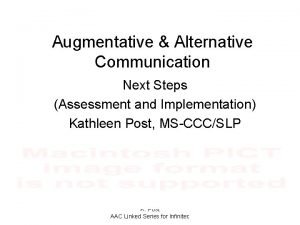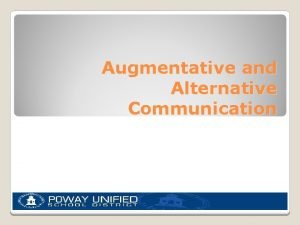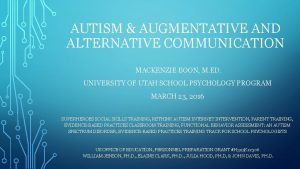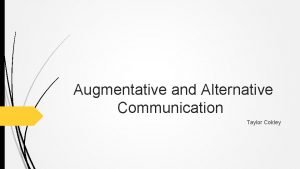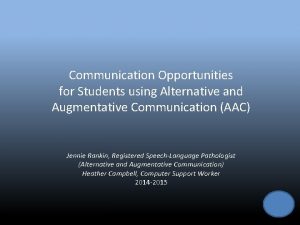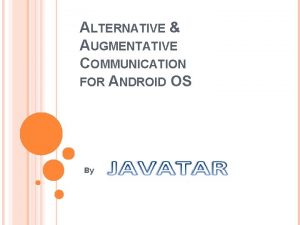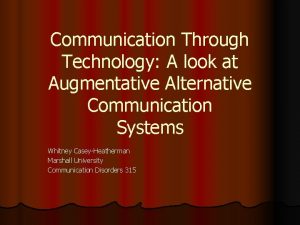An introduction to Augmentative and Alternative Communication AAC























- Slides: 23

An introduction to Augmentative and Alternative Communication (AAC) © NSW Department of Education | An introduction of Augmentative and Alternative Communication (AAC) 28 December 2021

What is Augmentative and Alternative Communication (AAC)? Symbols, aids, strategies and techniques that serve to supplement speech Hierarchy of symbols Easiest Objects Logos Photographs Line drawings Orthography Most difficult NSW Public Schools – Leading the Way Speech © NSW Department of Education | An introduction of Augmentative and Alternative Communication (AAC) 28 December 2021

Types of AAC Unaided Support Aided Support Body language Facial expressions Gesture Mime Key Word Signing AUSLAN Finger Spelling Olfactory (smell) Objects Logos Photographs Line Drawings - pictographs - symbols Sight Vocabulary Orthography Speech/Vocalisations NSW Department of Education & Training NSW Public Schools – Leading the Way © NSW Department of Education | An introduction of Augmentative and Alternative Communication (AAC) 28 December 2021

Why use AAC? NSW Public Schools – Leading the Way Some students may have biological and neurological impairments. Speech is complex, transient and most importantly functional © NSW Department of Education | An introduction of Augmentative and Alternative Communication (AAC) 28 December 2021

Why use visuals? Improve understanding and expression decrease fear & anxiety teach self management enhance memory aid shifting & establishing attention promote independence Support appropriate behaviour NSW Department of Education & Training NSW Public Schools – Leading the Way © NSW Department of Education | An introduction of Augmentative and Alternative Communication (AAC) 28 December 2021

Why use visual communication? Some students may be visual learners Visual communication is permanent, consistent, tangible & concrete NSW Public Schools – Leading the Way © NSW Department of Education | An introduction of Augmentative and Alternative Communication (AAC) 28 December 2021

Profile of a visual learner A visual learner may: prefer to read, to see the words, illustrations and diagrams talk quite fast, using lots of images memorise by writing repeatedly when inactive, looks around, doodles or watches something when starting to understand something says, ‘that looks right’ be most distracted by untidiness NSW Department of Education & Training © NSW Department Education An introduction of Augmentative and Alternative Communication (AAC) NSW Public Schools –of. Leading the | Way 28 December 2021

Using an AAC approach A multimodal approachstudents may need more than one approach i. e. speech, sign, symbol Immersion in AAC across environments Practice within everyday activities at home, school and community NSW Department of Education & Training © NSW Department Education An introduction of Augmentative and Alternative Communication (AAC) NSW Public Schools –of. Leading the | Way 28 December 2021

Using symbolic representationreal objects As visual learners most students can be supported by the use of visual prompts. Starting with the ‘real object’ or an ‘object of reference’ supports understanding. ‘Objects of reference’ are usually real objects representing daily routines e. g. a cup could represent a drink or an armband could represent swimming. Objects needs to be portable and easily accessible. Substituting real objects may be more practical - a fridge magnet could depict a pizza. NSW Department of Education & Training NSW Public Schools – Leading the Way © NSW Department of Education | An introduction of Augmentative and Alternative Communication (AAC) 28 December 2021

Why use real objects? By using a concrete object to represent an abstract concept, the real object can provide the student with an increased understanding of expectations. This may reduce anxiety and the subsequent challenging behaviour. Using real objects will allow students to: develop communication skills so the student can indicate their needs and wants. anticipate events and understand what is currently happening make choices to control what is happening understand time, sequences and events have the opportunity to learn daily routines learn a new activity as an adult introduces it. NSW Department of Education & Training NSW Public Schools – Leading the Way © NSW Department of Education | An introduction of Augmentative and Alternative Communication (AAC) 28 December 2021

Real objects can be used to: enable the student to increase independence by accessing a bank of real objects to indicate a preference and/or meet their immediate needs. introduce a change of activity where the student is encouraged to handle the real object relevant to each activity indicate the end of the activity by removal of the object provide a visual timetable with a sequence of real objects displayed and removed as appropriate NSW Public Schools – Leading the Way © NSW Department of Education | An introduction of Augmentative and Alternative Communication (AAC) 28 December 2021

Assessing symbolic understanding What does the student currently use? objects logo/ symbol picture word coke What does the student look at/attend to? person, object, favourite toy etc. What does the student select when given a choice? How does the student link this to their need? will point to, request using a sign, exchange symbol, locate with verbal direction NSW Department of Education & Training NSW Public Schools – Leading the Way © NSW Department of Education | An introduction of Augmentative and Alternative Communication (AAC) 28 December 2021

Visual supports in a range of environments Photos assist with sequencing and reduce verbal directions to build student independence. An example of visuals supporting behaviour and tasks at home. © NSW Department of Education | An introduction of Augmentative and Alternative Communication (AAC) 28 December 2021

Tips for making visuals - photos Centre the object Eliminate backgrounds or other items – use a plain background if possible Where possible, make photos generic. © NSW Department of Education | An introduction of Augmentative and Alternative Communication (AAC) 28 December 2021

Making visuals - photos Photos should: be well-defined and clearly focused only contain one object at a time when teaching new vocabulary have a written label towel © NSW Department of Education | An introduction of Augmentative and Alternative Communication (AAC) 28 December 2021

Making visuals - photos Avoid using a flash which can result in a distraction to the photo for students with ASD. © NSW Department of Education | An introduction of Augmentative and Alternative Communication (AAC) 28 December 2021

Designing visual systems When developing a visual system you need to consider the following issues for the student: cognitive skills portability durability accessibility visual skills storage ownership of system NSW Department of Education & Training NSW Public Schools – Leading the Way © NSW Department of Education | An introduction of Augmentative and Alternative Communication (AAC) 28 December 2021

Making visuals – using velcro Communication systems and individual symbols become inter-changeable and compatible, providing you follow the: GOLDEN VELCRO RULE!! SOFT VELCRO (LOOP) ON THE WALLS, BOARD OR BOOK (can also use Frontrunner fabric) Velcro loop ROUGH VELCRO (HOOK) ON THE INDIVIDUAL SYMBOLS Velcro hook © NSW Department of Education | An introduction of Augmentative and Alternative Communication (AAC) 28 December 2021

Consider a student’s visual skills follow recommendations by a therapist if available visual perception skills – colours and patterns knowledge of a specific disability i. e. vision impairment, tracking ability, colour blindness etc age specific requirements such as use of colour and/or text/font © NSW Department of Education | An introduction of Augmentative and Alternative Communication (AAC) 28 December 2021

Consider language Use the language of the student or their equivalent age group peers Where possible develop the communication system in consultation with the student stir fry Chinese © NSW Department of Education | An introduction of Augmentative and Alternative Communication (AAC) 28 December 2021

Accessing symbols Symbols for visual supports can be accessed from a variety of sources including the following: empty packets broken equipment remnants from activities labels from packaging catalogues & advertisements photo software programs e. g. Picture This and Flash Pro Boardmaker – Picture Communication Symbols (PCS) Writing With Symbols – PCS and Rebus websites – www. do 2 learn. com and http: //usevisualstrategies. com/visual-strategies/printable-picturecards/ NSW Public Schools – Leading the Way © NSW Department of Education | An introduction of Augmentative and Alternative Communication (AAC) 28 December 2021

False assumptions about using visuals and the students who need them It will stop him from learning to talk. He understands everything I say. It will make him look disabled. He can’t use that, he’s an adult. I know what he wants. NSW Department of Education & Training © NSW Department Education An introduction of Augmentative and Alternative Communication (AAC) NSW Public Schools –of. Leading the | Way 28 December 2021

I hear and I forget. I see and I remember. I do and I understand. Chinese proverb. NSW Department of Education & Training © NSW Department Education An introduction of Augmentative and Alternative Communication (AAC) NSW Public Schools –of. Leading the | Way 28 December 2021
 Tips for augmentative and alternative communication success
Tips for augmentative and alternative communication success Aac profile assessment
Aac profile assessment Augmentativ exemple
Augmentativ exemple Cabeza grande augmentative
Cabeza grande augmentative Aac and apraxia
Aac and apraxia No tech aac examples
No tech aac examples 18 aac 75
18 aac 75 Coverage vocabulary aac
Coverage vocabulary aac Amazon oxygen production
Amazon oxygen production Aac goals
Aac goals Just in time programming aac
Just in time programming aac Aac implementation plan
Aac implementation plan Aac evaluation genie
Aac evaluation genie Aac
Aac Tertiary aac assessment centre
Tertiary aac assessment centre Crooked house aac
Crooked house aac Aac implementation plan
Aac implementation plan Winamp aac encoder
Winamp aac encoder It acquisition advisory council
It acquisition advisory council Aac sig
Aac sig Air armament center
Air armament center What is oral communication and written communication
What is oral communication and written communication Meaning of oral communication
Meaning of oral communication Parallel communication examples
Parallel communication examples
